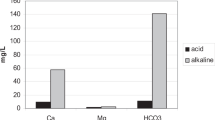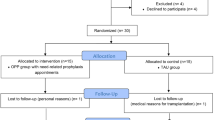Abstract
Background
Sodium bicarbonate, in the form of baking soda, is widely used as a home remedy, and as an additive for personal and household cleaning products. Its toxicity has previously been reported following oral ingestion in the setting of dyspepsia. However, its use as a non-ingested agent, like a toothpaste additive, has not been reported as a potential cause of toxicity.
Case presentation
We are reporting a case of an 80-year-old woman who presented with chronic metabolic alkalosis and hypokalemia secondary to exogenous alkali exposure from baking soda as a toothpaste additive, which might have represented an underreported ingestion of the substance.
Conclusions
Considering that one teaspoon of baking soda provides approximately 59 m-equivalents (mEq) of bicarbonate, specific questioning on its general use should be pursued in similar cases of chloride resistant metabolic alkalosis.
Similar content being viewed by others
Background
Sodium bicarbonate is widely known for its multiple uses as a home remedy and as an additive for personal and household cleaning products. As a strong base, it serves as a buffer to neutralize acid, and its consumer use stems from its properties as a deodorizing, degreasing, and cleaning agent. Sodium bicarbonate toxicity manifesting as metabolic alkalosis has previously been reported following oral ingestion in the setting of dyspepsia [1, 2]. However, its use as a non-ingested agent, like a toothpaste additive, has not been reported as a potential cause of toxicity.
Case presentation
An 80-year-old woman with a past medical history of long-standing hypertension leading to chronic kidney disease (CKD) stage G3bA1 (baseline serum creatinine 1.4–1.78 mg/dL [123.7–157.35 umol/L], eGFR 33–45 mL/min), hyperlipidemia, atrial fibrillation and gastroesophageal reflux disease was referred to the Nephrology clinic by her primary care provider for evaluation of chronic metabolic alkalosis.
During her initial clinic visit, the patient endorsed decreased appetite and poor oral intake with resultant 5-pound weight loss over the course of 6 weeks. She denied any nausea, vomiting or diarrhea. Her home medications included metoprolol tartrate 50 mg twice daily, pravastatin 10 mg daily, pantoprazole 40 mg daily, rivaroxaban 15 mg daily, and calcium carbonate 600 mg daily. She specifically denied taking any additional medications, either prescribed or over-the-counter. On physical examination, the patient had a BMI of 17.2 kg/m2, blood pressure of 160/80 mmHg and heart rate of 80 beats per minute. She was clinically euvolemic on exam, particularly, there was no peripheral edema. Table 1 summarizes the patient’s initial serum laboratory findings. Notably, her serum bicarbonate was elevated to 44 mmol/L, urinalysis was unremarkable, with no proteinuria or active urine sediment, and urine pH of 6.0, which was somewhat lower than expected for her degree of metabolic alkalosis. Based on the arterial blood gas result with a pH of 7,50, CO2 53 mmHg (7.06 kPa) and bicarbonate 41 mEq/L, the patient was diagnosed with a primary compensated metabolic alkalosis. Spot urine electrolytes revealed the following: urine sodium of 41 mmol/L (fractional excretion of 0.3%), potassium 13.0 mmol/L (fractional excretion 3.87%) and chloride 48 mmol/L (fractional excretion of 0.5%), with a urine creatinine of 128 mg/dL (11,317 umol/L). Her random urine chloride level greater than 20 mmol/L was indicative of a predominantly chloride-resistant metabolic alkalosis. In the setting of the patient’s hypertension associated with metabolic alkalosis and tendency to hypokalemia, further workup was obtained after her serum potassium level was repleted to 3.8 mEq/L, to rule out secondary causes of hypertension. Laboratory workup showed a serum renin level of 0.2 ng/mL/h (reference: 0.25–5.82 ng/mL) with normal serum aldosterone level of 3.6 ng/dL supine (Ref: if supine 3–16 ng/dl, upright less or equal to 28 ng/dl) and AM cortisol level of 13.4 mcg/dL (Ref at 7–9 am: 4.6–23.4 mcg/dL). A computed tomography scan of her abdomen was obtained and showed normal-appearing adrenal glands. Further, renal vascular ultrasound was unremarkable with no evidence of renal artery stenosis.
Following initial extensive evaluation, the patient’s medications were again reviewed at a subsequent visit, this time with her daughter present. Upon questioning specifically on the use of baking soda, her daughter reported that the patient had been brushing her teeth with this substance at least three times a day for the prior 6 months. The patient reported that her friend recommended it for her to improve her teeth hygiene. Upon discontinuation of this practice, repeat labs 3 days later showed significant improvement in her serum bicarbonate level to 34 mmol/L, with a serum potassium level of 3.8 mmol/L (Table 1). However, the patient restarted brushing her teeth with baking soda and follow up labs showed again a higher serum bicarbonate of 39 mmol/L and a serum potassium of 3.0 mmol/L (Table 1). Again, following cessation of this practice, her repeat serum bicarbonate improved to 32 mmol/L with a serum potassium level of 4.0 mmol/L (Table 1 and Fig. 1). Her mild hypochloremia at presentation was most likely due to urine chloride loses (urine chloride was 48 mmol/L), precipitated by volume expansion due to chronic sodium bicarbonate use.
Discussion and conclusions
This patient developed metabolic alkalosis due to exogenous alkali exposure from baking soda as a toothpaste additive, which to our knowledge has not been previously reported. Sodium bicarbonate toxicity in patients with CKD has been attributed to the impaired ability to excrete alkali loads [3]. This patient’s CKD placed her at a higher risk for toxicity. It is noted that the patient was on a low dose of calcium carbonate which provided further bases but did not explain the severe alkalosis by itself. In addition, our patient’s serum calcium level was normal. The fact that her alkalosis improved after cessation of baking soda on two separate occasions confirmed that this was the main source of her acid base derangement. It is conceivable that some people, for example those with some degree of cognitive impartment, may have small unintentional ingestion of toothpaste, which might have led to gastrointestinal absorption of baking soda in this patient’s case. One teaspoon of baking soda provides approximately 59 m-equivalents (mEq) of bicarbonate, while one 650-mg tablet of sodium bicarbonate provides only 7.7 mEq of bicarbonate [3, 4]. This explains the higher risk of alkalosis with a product that is widely available over the counter to all the population. Sodium bicarbonate toxicity is mostly related with its use as antacid and in smaller proportions as a strategy to cause false negative illicit drug tests and to treat UTIs [1,2,3]. Nonetheless, physicians should be aware of this common but underreported use of toxicity related to baking soda exposure.
Availability of data and materials
Not applicable.
Abbreviations
- mEq:
-
milli-equivalents
- CKD:
-
Chronic Kidney Disease
- eGFR:
-
estimated Glomerular Filtration Rate
- BMI:
-
Body mass index
- UTIs:
-
Urinary Tract Infections
References
Al-Abri SA, Kearney T. Baking soda misuse as a home remedy: case experience of the California poison control system. J Clin Pharm Ther. 2014;39(1):73–7.
Ajbani K, Chansky ME, Baumann BM. Homespun remedy, homespun toxicity: baking soda ingestion for dyspepsia. J Emerg Med. 2011;40(4):e71–4.
Dubose TD. Metabolic Alkalosis. In: Gilbert S, Weiner D, editors. National Kidney FOundation Primer on Kidney Diseases; 2017. p. 137–43.
Yi JH, Han SW, Song JS, Kim HJ. Metabolic alkalosis from unsuspected ingestion: use of urine pH and anion gap. Am J Kidney Dis. 2012;59(4):577–81.
Acknowledgements
Not applicable.
Funding
Not applicable.
Author information
Authors and Affiliations
Contributions
CEC wrote the first draft, MH and SM reviewed the manuscript and applied all the changes requested by co-authors, and BGJ reviewed the final versions and made the final edits prior to submission. All authors read and approved the final manuscript.
Corresponding author
Ethics declarations
Ethics approval and consent to participate
Not applicable.
Consent for publication
Written informed consent was obtained from the patient to publish the potentially identifiable information contained within the manuscript. A copy of the consent form is available for review by the editor of the journal from the corresponding author and can be provided on request.
Competing interests
The authors declare that they have no competing interests.
Additional information
Publisher’s Note
Springer Nature remains neutral with regard to jurisdictional claims in published maps and institutional affiliations.
Rights and permissions
Open Access This article is licensed under a Creative Commons Attribution 4.0 International License, which permits use, sharing, adaptation, distribution and reproduction in any medium or format, as long as you give appropriate credit to the original author(s) and the source, provide a link to the Creative Commons licence, and indicate if changes were made. The images or other third party material in this article are included in the article's Creative Commons licence, unless indicated otherwise in a credit line to the material. If material is not included in the article's Creative Commons licence and your intended use is not permitted by statutory regulation or exceeds the permitted use, you will need to obtain permission directly from the copyright holder. To view a copy of this licence, visit http://creativecommons.org/licenses/by/4.0/. The Creative Commons Public Domain Dedication waiver (http://creativecommons.org/publicdomain/zero/1.0/) applies to the data made available in this article, unless otherwise stated in a credit line to the data.
About this article
Cite this article
Cervantes, C.E., Menez, S., Jaar, B.G. et al. An unusual cause of metabolic alkalosis: hiding in plain sight. BMC Nephrol 21, 296 (2020). https://doi.org/10.1186/s12882-020-01967-7
Received:
Accepted:
Published:
DOI: https://doi.org/10.1186/s12882-020-01967-7





